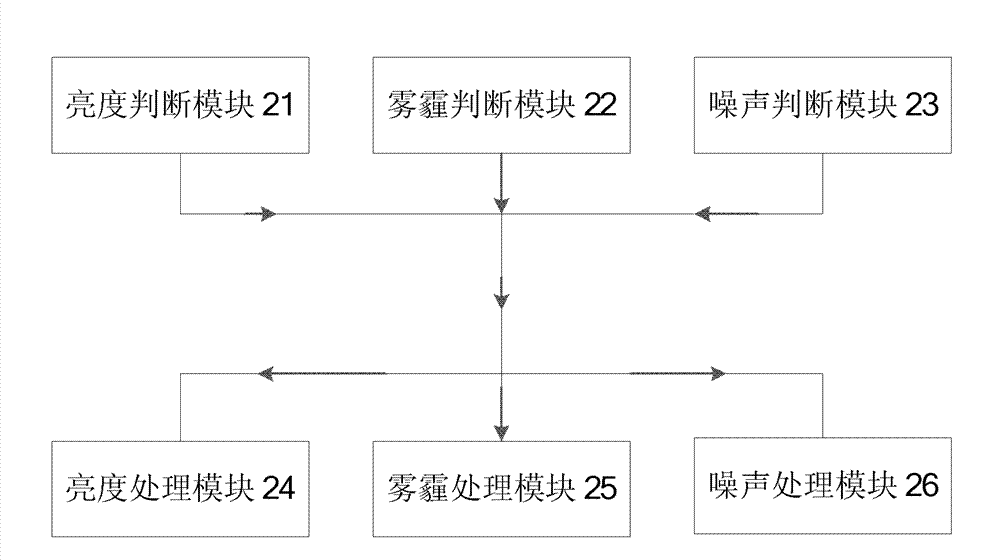Adaptive enhancement method and device for monitored video
A technology for self-adaptive enhancement and monitoring video, which is applied in the parts of color TV, TV system, TV, etc. It can solve the problems of complex working application scenarios of video monitoring system, and achieve the effect of improving image quality and optimizing processing.
- Summary
- Abstract
- Description
- Claims
- Application Information
AI Technical Summary
Problems solved by technology
Method used
Image
Examples
Embodiment 1
[0068] The position of the self-adaptive enhancing device of monitoring video of the present invention in the system is as follows figure 1 As shown, the adaptive enhancement device performs adaptive judgment on the original image data output by the camera, performs corresponding processing, and then outputs the processed target image data to the monitor. The original image in this embodiment is in YUV format.
[0069] The structure of the self-adaptive enhancing device of monitoring video described in the present invention is as follows: figure 2 As shown, it is composed of a brightness judgment module 21, a haze judgment module 22, a noise judgment module 23, a brightness processing module 24, a haze processing module 25 and a noise processing module 26.
[0070] The structure of brightness judging module 21 is as image 3 As shown, it consists of a brightness average calculation unit 211 and a brightness processing judgment unit 212 .
[0071] The mean brightness calcul...
Embodiment 2
[0141] Based on the device described in Embodiment 1, in this embodiment, the overall flow chart of the adaptive enhancement method for surveillance video is as follows Figure 10 As shown, the steps are as follows:
[0142] Step 1: Original image input, sending the video image collected by the front end to the adaptive enhancement device for monitoring video described in Embodiment 1.
[0143] Step 2: judging whether brightness processing is required, and judging whether the brightness of the input video image needs to be processed. If it is judged that brightness processing is required, proceed to step 3, and perform brightness processing on the video image; otherwise, proceed to step 4, and judge whether the video image needs haze removal processing.
[0144] Step 3: Luminance processing, performing luminance processing on the video image judged to need luminance processing in step 2, after the processing is completed, enter into step 6, and judge whether the video image n...
Embodiment 1)
[0174] Step 6: Calculate the gamma correction function according to the brightness level of the image calculated in step 3, so as to generate the mapping table g(X ij ) (see Example 1 for the calculation method):
[0175] Step 7: Perform enhancement processing on the video image according to the mapping table generated in Step 6.
[0176] The flow of haze treatment steps is as follows: Figure 15 As shown, the specific steps are as follows:
[0177] Step 1: Obtain the brightness component (Y channel component) of the original input image.
[0178] Step 2: Count the histogram of the brightness component, traverse the entire image, and count the gray histogram of the image (see Example 1 for the calculation method):
[0179] Step 3: Calculate the probability sum before storing each gray level to obtain a new histogram (see Example 1 for the calculation method).
[0180] Step 4: Use the new histogram to traverse each pixel to obtain the enhanced brightness component. In this...
PUM
 Login to View More
Login to View More Abstract
Description
Claims
Application Information
 Login to View More
Login to View More - R&D
- Intellectual Property
- Life Sciences
- Materials
- Tech Scout
- Unparalleled Data Quality
- Higher Quality Content
- 60% Fewer Hallucinations
Browse by: Latest US Patents, China's latest patents, Technical Efficacy Thesaurus, Application Domain, Technology Topic, Popular Technical Reports.
© 2025 PatSnap. All rights reserved.Legal|Privacy policy|Modern Slavery Act Transparency Statement|Sitemap|About US| Contact US: help@patsnap.com



